DSG2
-
Official Full Name
desmoglein 2 -
Overview
Desmoglein 2, also known as DSG2, is a human gene. Desmosomes are cell-cell junctions between epithelial, myocardial, and certain other cell types. Desmoglein 2 is a calcium-binding transmembrane glycoprotein component of desmosomes in vertebrate epitheli -
Synonyms
DSG2;desmoglein 2;desmoglein-2;CDHF5;HDGC;cadherin family member 5;ARVC10;ARVD10;CMD1BB;MGC117034;MGC117036;MGC117037
Recombinant Proteins
- Human
- Mouse
- Mammalian Cells
- HEK293
- E.coli
- HeLa
- Insect Cells
- Non
- Avi
- Fc
- His
- SUMO
- Myc
Background
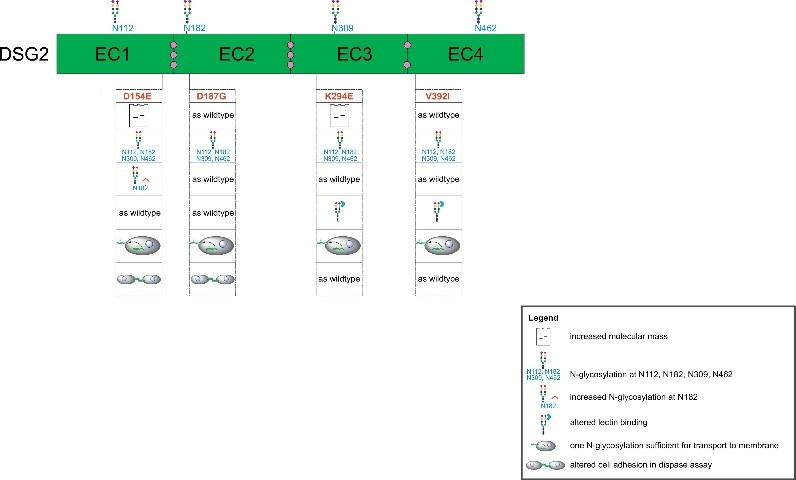
Fig1. Schematic graphic of the extracellular cadherin domains (EC1-4) of DSG2 with N-glycosylations (N112, N182, N309, N462) and complexed Ca2+-ions (purple).
What is DSG2 protein?
DSG2 (desmoglein 2) gene is a protein coding gene which situated on the long arm of chromosome 18 at locus 18q12. This gene encodes a member of the desmoglein family and cadherin cell adhesion molecule superfamily of proteins. The encoded protein, DSG2 is a calcium-binding transmembrane glycoprotein component of desmosomes in vertebrate epithelial cells. It provides cellular adhesion and forces transduction by cell-to-cell anchorage. It also plays a role in embryonic stem cell proliferation. The DSG2 protein is consisted of 1118 amino acids and its molecular mass is approximately 122.3 kDa.
What is the function of DSG2 protein?
DSG2 is a calcium-dependent cell adhesion protein, a member of the desmosomal protein family. It maintains the structural integrity of the skin by interacting with other desmosomal proteins to enhance the adhesion between epidermal cells. It helps to maintain the barrier function of the skin and prevent the invasion of harmful substances and pathogens. It's even involved in the regulation of immune responses.
DSG2 Related Signaling Pathway
Because DSG2 is a calcium-dependent cell adhesion protein, the most important signaling pathway involved in DSG2 is the cell adhesion related pathway. Its binding with calcium ions can regulate the conformation and affinity of DSG2, thereby regulating calcium ion signaling pathways affecting cell adhesion. At the same time, its interaction with some desmosomal proteins can also affect intercellular adhesion. Other signaling pathways such as immune signaling pathways, muscle contraction pathways, and stress responses may also be involved.
DSG2 Related Diseases
DSG2 is mainly expressed in the heart, skin and skeletal muscle and is involved in cell adhesion and the formation of intercellular connections. Abnormal DSG2 protein function or expression is associated with a variety of diseases, some of which include: Arrhythmogenic right ventricular cardiomyopathy/dysplasia (ARVD/C), Non-compaction cardiomyopathy (NCC) and some skin diseases, such as: pemphigus vulgaris (PV) and Pemphigus are also autoimmune diseases.
Bioapplications of DSG2
A number of anti-DSG2 antibody drugs have been developed for the treatment of DSG2-related diseases, including pemphigus, such as the anti-DSG2 monoclonal antibody expressed by Duxella yeast. There are other antibodies in clinical trials.
Case Study
Case study 1: Sabine Bernegger, 2021
High temperature requirement A (HtrA) is an active serine protease secreted by the group-I carcinogen Helicobacter pylori (H. pylori). The human cell adhesion protein and tumor suppressor E-cadherin (hCdh1) expressed on the surface of gastric epithelial cells was identified as the first HtrA substrate. In this study, the researchers performed a proteomic profiling of H. pylori HtrA (HpHtrA) to decipher the complex mechanism of H. pylori interference with the epithelial barrier integrity.
Using a proteomic approach, human desmoglein-2 (hDsg2), neuropilin-1, ephrin-B2, and semaphorin-4D were identified as novel extracellular HpHtrA substrates. HpHtrA-mediated hDsg2 cleavage was further analyzed by in vitro cleavage assays using recombinant proteins. In infection experiments, they demonstrated hDsg2 shedding from H. pylori-colonized MKN28 and NCI-N87 cells.
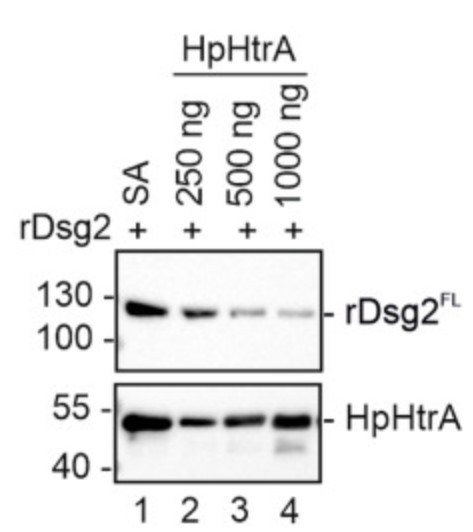
Fig1. 100 ng recombinant rDsg2 were incubated with indicated amounts of recombinant HpHtrA wildtype (wt) or 1 μg inactive HpHtrA (SA) for 16 h at 37 °C.
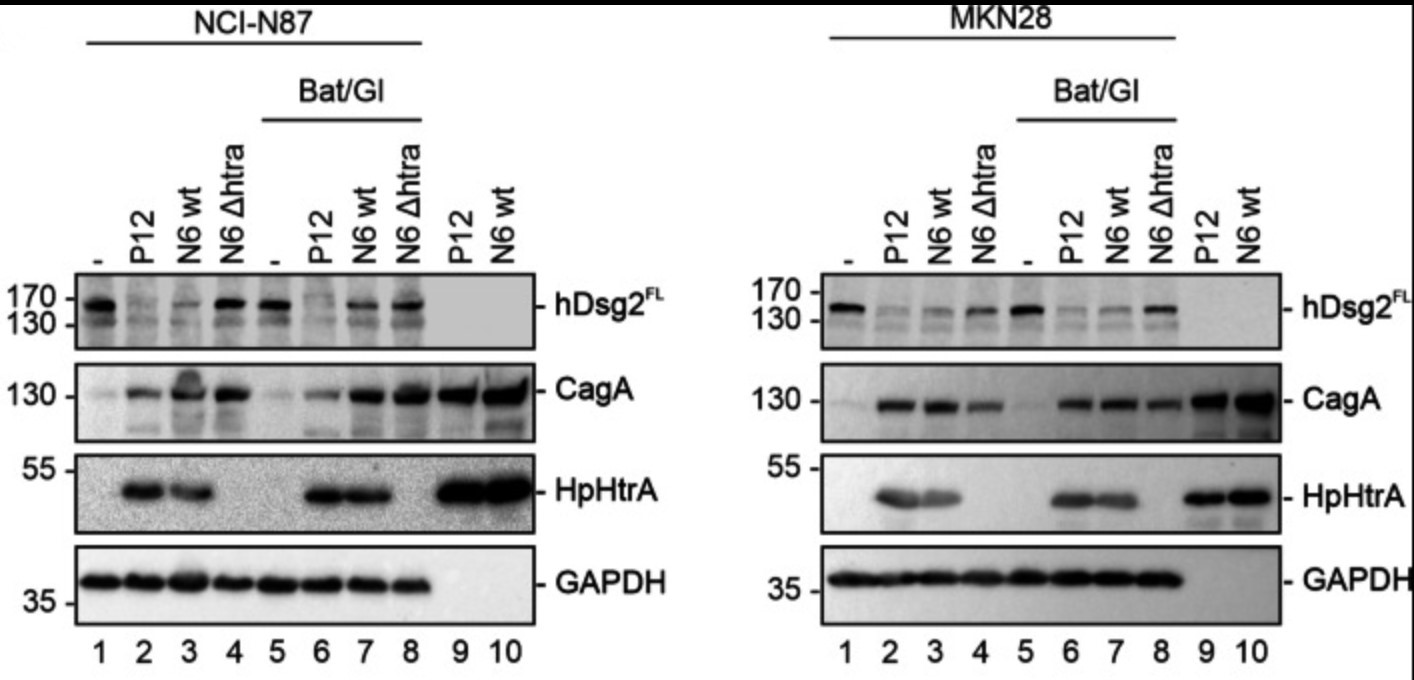
Case study 2: Shuhang Qin, 2020
The pathogenesis and developmental mechanism of early-stage (FIGO 2009 IA2-IIA2) cervical cancer (CC) remain unclear. Seeking novel molecular biomarkers based on The Cancer Genome Atlas (TCGA) will facilitate the understanding of CC pathogenesis and help evaluate early-stage CC prognosis.
Differential expression analysis identified upregulated genes in early-stage CC. And the researchers selected desmoglein-2 (DSG2) for further investigation. To detect DSG2 expression in early-stage CC, they used immunohistochemistry (IHC), quantitative real-time PCR (qRT-PCR) and western blotting. The correlations between DSG2 expression and CC cell line proliferation and migration were investigated with Cell Counting Kit-8 (CCK-8) and migration assays. Coexpression analysis indicated that DSG2 was probably involved in cell division, positive regulation of transferase activity, positive regulation of cell migration, EGFR upregulation pathway and regulation of lymphangiogenesis. IHC, qRT-PCR and western blotting showed that DSG2 expression was higher in CC than in normal tissue. DSG2 knockdown inhibited CC cell proliferation and migration.

Fig3. The mRNA expression of DSG2 was determined by qRT-PCR in 20 NCTs and 20 CC samples (left). The protein expression of DSG2 was determined by western blotting in 3 NCTs and 3 CC samples (right).

Quality Guarantee
High Purity
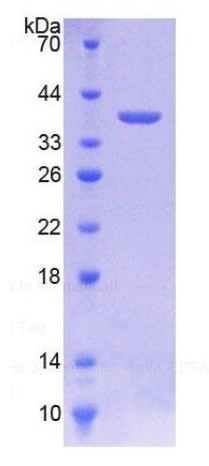
Fig1. SDS-PAGE (DSG2-400H) (PROTOCOL for western blot)
.
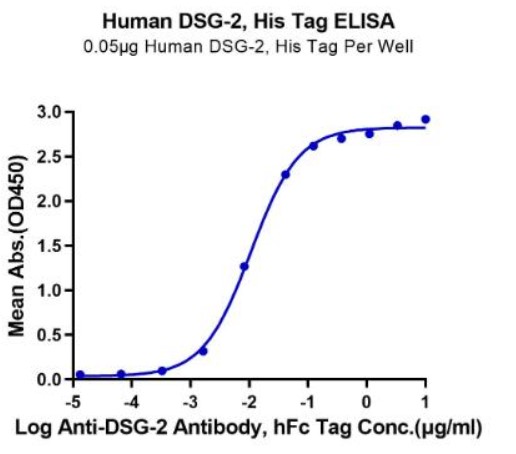
Fig2. Activity Data. (DSG2-510H)
Involved Pathway
DSG2 involved in several pathways and played different roles in them. We selected most pathways DSG2 participated on our site, such as Apoptosis,Apoptotic cleavage of cell adhesion proteins,Apoptotic cleavage of cellular proteins, which may be useful for your reference. Also, other proteins which involved in the same pathway with DSG2 were listed below. Creative BioMart supplied nearly all the proteins listed, you can search them on our site.
| Pathway Name | Pathway Related Protein |
|---|---|
| Arrhythmogenic right ventricular cardiomyopathy (ARVC) | ITGA5,CACNG3,DMD,ITGA2,EMD,SGCA,CTNNA1,ITGA3,ACTG1,CACNG4 |
| Programmed Cell Death | STK24A,BCAP31,DBNL,HMGB2A,DIABLOA,DBNLB,GZMC,GZMF,Gzmg,GZME |
| Apoptotic cleavage of cellular proteins | STK26,CTNNB1,CLSPN,PLECA,PLEC,LMNB1,OCLN,CTNNB2,DBNLB,SATB1 |
| Arrhythmogenic right ventricular cardiomyopathy | CACNG3,CTNNA2,DAG1,JUP,DMD,DES,CTNNA1,DSP,CDH2,DSC2 |
| Apoptotic execution phase | DBNL,STK24,HIST1H1E,OCLN,CTNNB1,HMGB2A,BCAP31,HIST1H1D,DSG3,CASP6L2 |
| Apoptotic cleavage of cell adhesion proteins | DSG1,DSP,CTNNB1,PTBP3,OCLN,CTNNB2,PKP1,DSG3 |
| Apoptosis | DIABLO,DAPK1,BIRC8,IL1B,STK24B,PRKAR2A,AKT2L,FADD,IL1B2,PIK3R3 |
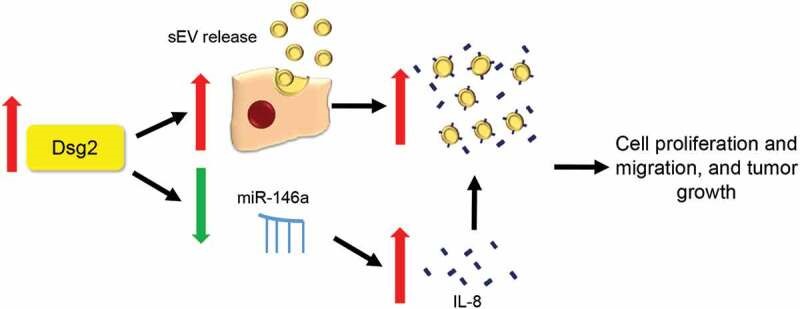
Fig1. Schematic showing putative mechanism for increased tumorigenesis in SCC cells via Dsg2-dependent miR-146a down-regulation. (Joseph P Flemming, 2020)
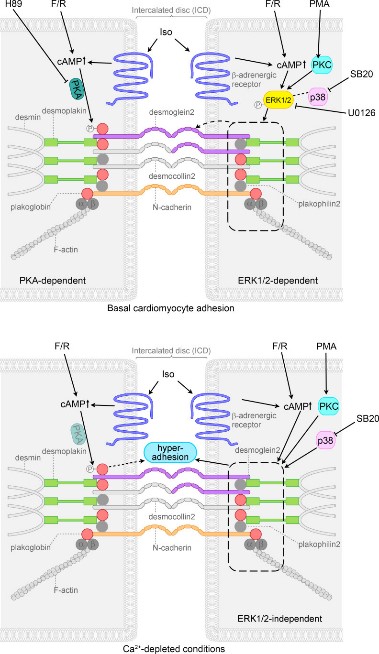
Fig2. Schematic overview of signaling mechanisms involved in cohesion in HL-1 cardiomyocytes. (Maria Shoykhet, 2020)
Protein Function
DSG2 has several biochemical functions, for example, calcium ion binding,cell adhesion molecule binding,cell adhesive protein binding involved in bundle of His cell-Purkinje myocyte communication. Some of the functions are cooperated with other proteins, some of the functions could acted by DSG2 itself. We selected most functions DSG2 had, and list some proteins which have the same functions with DSG2. You can find most of the proteins on our site.
| Function | Related Protein |
|---|---|
| cell adhesive protein binding involved in bundle of His cell-Purkinje myocyte communication | CTNNA3,DSP,PKP2,DSC2,JUP |
| cell adhesion molecule binding | Fert2,CADM2,TIGIT,CPE,NLGN1,NLGN3,SDCBP,ITGAL,PVRL1B,CD1D |
| calcium ion binding | S100A8,CCDC47,SYT10,LRP4,PADI6,CDH18A,PLA2G2D,S100A4,ANXA5A,OC90 |
Interacting Protein
DSG2 has direct interactions with proteins and molecules. Those interactions were detected by several methods such as yeast two hybrid, co-IP, pull-down and so on. We selected proteins and molecules interacted with DSG2 here. Most of them are supplied by our site. Hope this information will be useful for your research of DSG2.
ganglioside_gm1;JUP;Cbx1;DSC2;Trim69;Flot1;PDGFRA;FLNA;MYH9;Bmpr1a;IQGAP1;Tpm1;Actb;ACTR2;Ppp1cb;Jup;DBN1
Resources
Research Area
Related Services
Related Products
References
- Espana, A; Koga, H; et al. Antibodies to the amino-terminal domain of desmoglein 1 are retained during transition from pemphigus vulgaris to pemphigus foliaceus. EUROPEAN JOURNAL OF DERMATOLOGY 24:174-179(2014).
- Toumi, A; Saleh, MA; et al. Autoimmune reactivity against precursor form of desmoglein 1 in healthy Tunisians in the area of endemic pemphigus foliaceus. JOURNAL OF DERMATOLOGICAL SCIENCE 70:19-25(2013).




